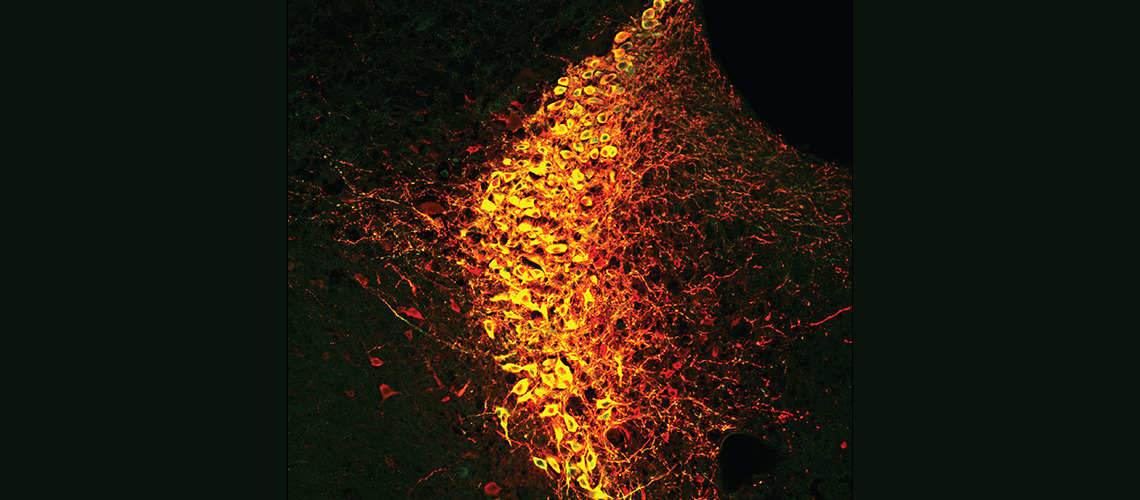Follow us on Google News (click on ☆)
A study conducted by neuroscientists from the University of Geneva (UNIGE), in collaboration with ETH Zurich, shows that a brain region called the locus coeruleus (LC) and the neurotransmitter norepinephrine act as true conductors, allowing for the reorganization of brain functions as needed for the concentration at hand.

The norepinephrinergic neurons of the locus coeruleus (LC) play a key role in the shift from a concentrated state to a state of alertness. The image shows these neurons in a mouse brain.
© UNIGE / ETH Zurich
The study, published in the journal Nature Neuroscience, demonstrates that the triggering mode of the LC neurons facilitates switching from one state of concentration to another. This discovery helps deepen the understanding of healthy brain functions and human cognition, and could influence approaches aimed at optimizing performance and well-being.
How do athletes achieve the concentration required to excel in their discipline? The answer lies in the brain's remarkable ability to focus on a single task by filtering out distractions.
This phenomenon—known in sports as "being in the zone"—is not only an essential skill for athletes but also for anyone facing a challenging task, like taking an exam or mastering a musical instrument. However, at times, these individuals must also be capable of being fully aware of their surroundings, especially when it comes to spotting potential dangers.
A tiny structure
Neuroscientists from UNIGE and ETH studied what enables the brain to switch from this intense focal concentration to heightened global awareness. The research team focused on norepinephrine—a neurotransmitter known to be involved in regulating attention—released from a small region located deep in the brain called the locus coeruleus (LC), which plays a role in environmental awareness.
"Its small size and deep location were immediately challenging. In humans, it is very difficult to observe, and it's impossible to externally control its functioning. For these reasons, we turned to the mouse. In mice, the LC consists of about three thousand neurons, yet it still has a remarkable influence over the seventy-five million (75,000,000) neurons in the brain," explains Valerio Zerbi, assistant professor at the Department of Psychiatry and the Department of Fundamental Neurosciences at the UNIGE Faculty of Medicine, and initiator of the study.
Using advanced techniques—such as optogenetics to artificially manipulate the LC neurons in mice, and photometry to measure norepinephrine release—the LC's function was explored in collaboration with the laboratory of Johannes Bohacek, professor at ETH Zurich. Functional magnetic resonance imaging (fMRI), for its part, provided the first empirical evidence of how LC stimulation affects brain activity in different regions.
A question of rhythm
The neuroscientists discovered that when the LC fires three times per second at a continuous, so-called “tonic” rhythm, it does not have the same effects as when the same frequency is administered for only a short period, in a so-called “burst” rhythm. "When the LC fires in bursts, more norepinephrine is released, and the brain's sensory functions are prioritized. This brain mode allows mice to be more alert to their surroundings through their senses," explains Valerio Zerbi.
In contrast, when the LC fires in a tonic manner, less norepinephrine is released by the LC, and brain regions such as the prefrontal cortex and hippocampus are activated. These two structures are known for processing information and reflective thought, thus enabling intense concentration.
Mastering the locus coeruleus for performance
"The secret of top athletes could indeed lie in their mastery of their LC, although state-of-the-art equipment and meticulous training certainly play a part. By precisely controlling the activity of their LC, they can shift from an intense focus state to a state of global attention to achieve their performances," concludes Valerio Zerbi.
Thanks to the insights gained from this study, brain imaging could help athletes better utilize their LC to focus, notably through neurofeedback approaches—a technique that uses devices to monitor brain activity in real time and allows for its regulation based on visual feedback.